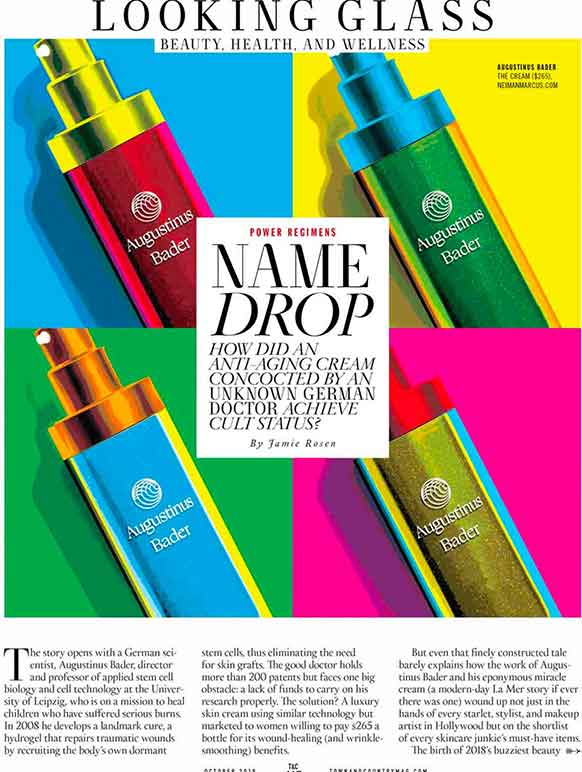"A truly effective anti-wrinkle cream"
The story opens with a German scientist, Augustinus Bader, director and professor of applied stem cell biology and cell technology at the University of Leipzig, who is on a mission to heal children who have suffered serious burns. In 2008 he develops a landmark cure, a hydrogel that repairs traumatic wounds by recruiting the body’s own dormant stem cells, thus eliminating the need for skin grafts. The good doctor holds more than 200 patents but faces one big obstacle: a lack of funds to carry on his research properly. The solution? A luxury skin cream using similar technology but marketed to women willing to pay $265 a bottle for its wound-healing (and wrinkle smoothing) benefits. But even that finely constructed tale barely explains how the work of Augustinus Bader and his eponymous miracle cream (a modern-day La Mer story if ever there was one) wound up not just in the hands of every starlet, stylist, and makeup artist in Hollywood but on the shortlist of every skincare junkie’s must-have items.
The birth of 2018’s buzziest beauty product really goes back to Bader’s introduction to biotech investor Charles Rosier. The two are put in touch in 2011 by Robert Friedland, a mining billionaire. Two years go by, and Rosier and Bader meet again. Bader wants to license his hydrogel technology in the hope of using the proceeds to fund a clinical trial, which could make the product more widely available. (The dream, Rosier says, is for it to be accessible to organizations like the Red Cross and Doctors Without Borders.) Rosier has an idea: “It came to my mind that somebody who can turn burned skin into perfect skin can probably cure wrinkles. So I went to him and said, ‘Can you do an anti-wrinkle cream that works?’ And his reply was, ‘Yes, why?’”
Rosier spends another two years making visits to Leipzig to convince Bader of the marketplace potential of a truly effective anti-wrinkle cream. Unknown to Rosier, Bader is already testing a cream with his private patients, who come to him for infusions that encourage microenvironmental repair in the body. He has developed the cream with a philosophy similar to the one behind the hydrogel: Give the skin what it needs to initiate its own repair. In the case of the cream, it was TFC8 (TFC stands for Trigger Factor Complex).
The ingredients don’t sound terribly unusual at first: a mix of vitamins, minerals, amino acids, and peptides. But, Bader says, sounding like a Michelin-starred chef, the key to using the best ingredients is “not to provide in abundance but in just the right concentration.” When you’re able to do that, he says, you can influence epigenetic factors that enable the body to “fix your skin according to your own needs,” be they acne, pigment problems, wrinkles, or all of the above. The idea is that the cream is all you need (aside from cleanser and sunscreen), so there are only two products in the line. They are identical in active ingredients, but one has a richer texture. An early tester of Bader’s cream was a patient from California: Melanie Griffith. “He’s the sweetest man ever,” Griffith says. “All he cares about is helping people.” Within five days of trying the cream, she says, her skin was so dramatically changed she became an investor. (So is her ex, Don Johnson, and so are Courteney Cox and Carla Bruni.) Griffith, along with stylist Elizabeth Sulcer, told Cassandra Grey (of Violet Grey) about the cream last year. “Because of what we do, people send us things,” Grey says. “A lot of products are not revolutionary, even though they’re called revolutionary. This one was actually revolutionary.”
Soon the cream was available at 10 Corso Como in Milan, and a flagship Paris boutique was opened. Influential makeup artists like Daniel Martin and Pati Dubroff became converts. Dubroff, along with Diane Kruger, was recently named a brand ambassador. All of which has led to a social media tumble that keeps rolling. At press time around 15,000 bottles have been sold. Ten percent of the profits go to the Augustinus Bader Foundation to fund his medical work. And the mission, Rosier says, has become larger than selling skin cream: “Like everyone, we look for something that is bigger than us. I could not imagine something more meaningful for my life.” Along the way, investors, buyers, and customers have agreed. “We experienced no closed doors.”



